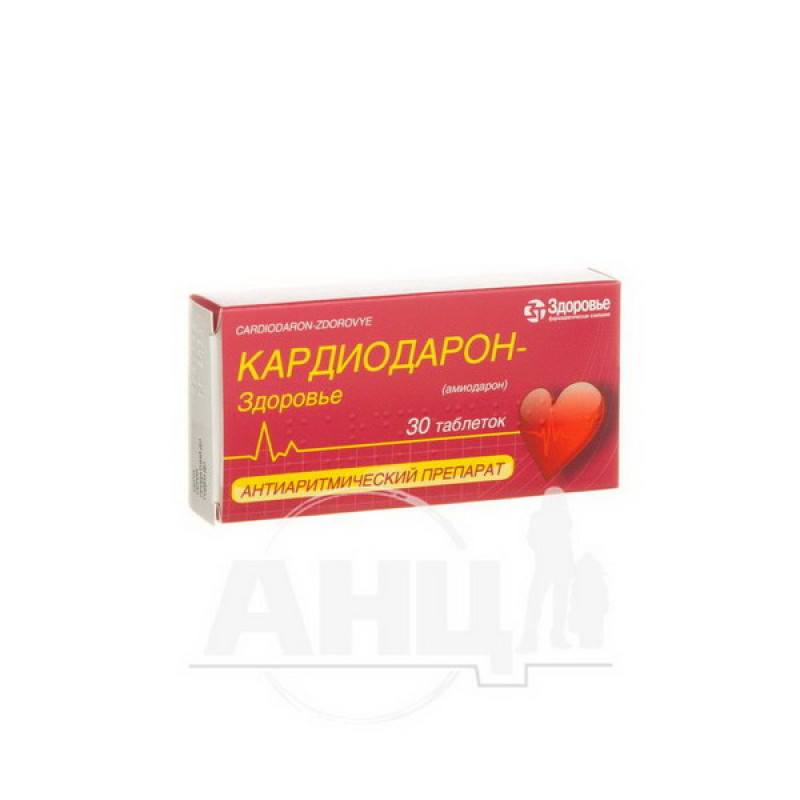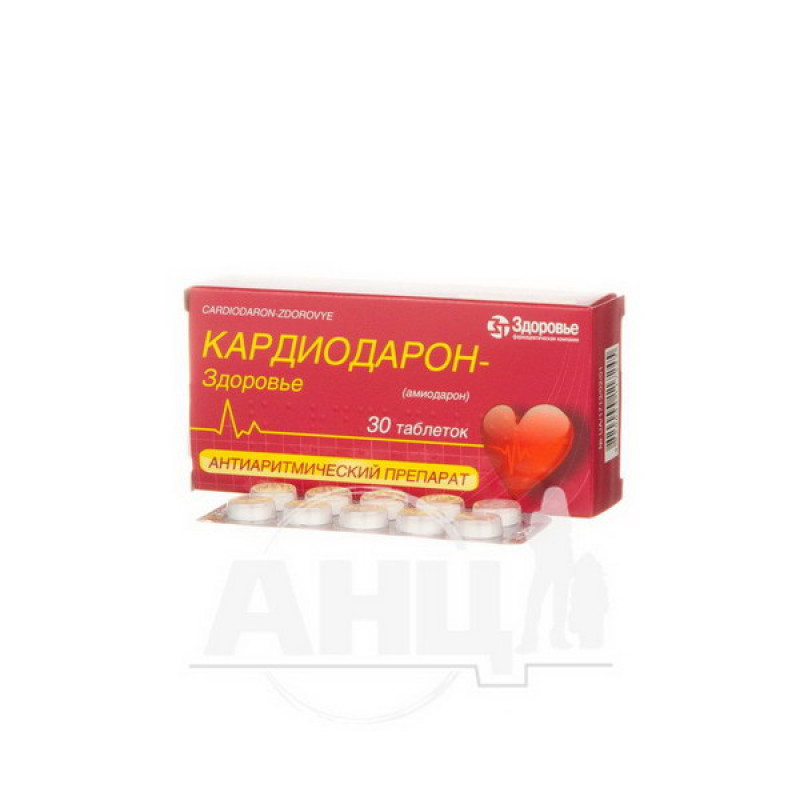Cardiodaron-Health tablets 200 mg blister No. 30

Pharmacological properties
Amiodarone ([2-butyl-3-benzofuranyl] - [4-(2-diethylaminoethoxy) -3,5-diiodophenyl] ketone hydrochloride) has antiarrhythmic (class III antiarrhythmics) and antianginal effects. The antiarrhythmic effect is due to the prolongation of the 3rd phase of the action potential due to a decrease in the potassium current through the channels of the cell membranes of cardiomyocytes. Increases the refractory period and reduces myocardial excitability. The drug non-competitively blocks α- and β-adrenoblocker receptors. Slows down sinoatrial, atrial and AV conduction, has practically no effect on intraventricular conduction. Slows down the conduction of excitation and increases the refractory period of additional atrioventricular pathways.
The antianginal effect is due to a decrease in myocardial oxygen demand (due to a decrease in heart rate and load on the heart), an increase in coronary blood flow through a direct effect on the smooth muscles of the coronary arteries, and support of cardiac output by reducing aortic pressure and OPSS.
After oral administration, it is slowly absorbed in the digestive tract. Bioavailability is 30-80%. The drug is detected in the blood 1/2 -4 hours after administration, the maximum concentration in the blood after a single dose is observed after 3-7 hours. After intravenous administration, the concentration of amiodarone in the blood decreases rapidly, while its distribution and accumulation in almost all tissues, especially adipose and muscle tissues of the myocardium, are detected. It is excreted from the body extremely slowly, the half-life is 20-100 days. It is metabolized in the liver with the formation of an active metabolite (decethylamiodarone), as well as by deiodination.
Indication
Treatment and prevention of paroxysmal cardiac arrhythmias (supraventricular tachycardia, wpw syndrome, ventricular tachycardia, atrial flutter, sinus tachycardia), as well as extrasystoles (supraventricular, ventricular). Prevention of recurrences: life-threatening ventricular tachycardia or ventricular fibrillation; ventricular tachycardia (documented) with clinical manifestations leading to disability; supraventricular tachycardia (documented) in heart diseases; rhythm disorders with resistance or contraindications to other treatment methods; wpw syndrome. Treatment of ventricular tachycardia (documented) in order to slow down the rhythm of ventricular contractions or restore sinus rhythm in atrial fibrillation and flutter. Cardiodarone can be prescribed to patients with coronary artery disease and/or left ventricular dysfunction.
Application
In / in: administered as an intravenous infusion. The initial dose is usually 5 mg/kg body weight in 250 ml of 5% glucose solution over 20-120 minutes. The infusion rate should be adjusted according to the effect obtained. The therapeutic effect of the drug is manifested within the first minutes of administration and disappears gradually. The administration can be repeated 2-3 times within 24 hours. Maintenance infusion: 10-20 mg/kg/day (average 600-800 mg/day) in 250 ml of 5% glucose solution for several days. The maximum daily dose is 1200 mg. From the first day of infusions, it is necessary to begin a gradual transition to oral administration.
Inside: the dose is set individually, taking into account possible side effects. As a rule, the drug is prescribed in an initial dose of 0.2 g 2-3 times a day (0.4-0.6 g/day) for 8-10 days (depending on the effect) under ECG control. In the future, they switch to a maintenance dose of 0.1-0.4 g/day. A possible scheme for prescribing the drug every other day in a dose of 0.2 g. In order to prevent cumulation, it is recommended to take a break for 2 days every 5 days.
Contraindication
Hypersensitivity to amiodarone and iodine, sinus bradycardia, sick sinus syndrome (in cases of absence of a pacemaker), sinoatrial blockade, AV blockade, simultaneous administration with drugs that can cause ventricular tachycardia of the "pirouette" type (antiarrhythmics, including bepridil, class IA drugs, sotalol, as well as vincamine, sultopride, erythromycin for IV administration, pentamidine for parenteral administration), hypothyroidism, hyperthyroidism, severe arterial hypotension, collapse, shock, pregnancy and breastfeeding, age up to 15 years.
Side effects
From the cardiovascular system: bradycardia (heart rate less than 55 beats / min), development or progression of arrhythmia, development or worsening of heart failure.
On the part of the digestive system: anorexia, nausea, vomiting, constipation, metallic taste in the mouth, rarely - increased activity of liver enzymes, pseudoalcoholic hepatitis, cirrhosis of the liver, acute renal failure.
From the side of the central nervous system and peripheral nervous system: paresthesia, tremor, ataxia, headache, fatigue, retrobulbar neuritis, polyneuropathy, dizziness, auditory hallucinations.
On the part of the organ of vision: lipofuscin deposition in the corneal epithelium (rarely - complaints of the appearance of colored halos when looking against the light).
Respiratory system: cough, progressive dyspnea, interstitial pneumonitis, pulmonary fibrosis, pleurisy, bronchitis.
From the endocrine system: hypothyroidism, hyperthyroidism.
Skin: photosensitivity, skin rash, hair loss.
Others: myopathy, epididymitis.
Special instructions
Before starting treatment, each patient is shown to have an ECG. During the period of treatment with Cardiodarone, as well as in the event of new arrhythmias or exacerbation of the underlying disease, ECG monitoring should be performed every 3 months.
Amiodarone may cause prolongation of the QT interval (due to delayed repolarization) and the appearance of a U wave on the ECG. These changes are not a manifestation of cardiotoxicity.
If sinoatrial block, AV block II-III degree, or bundle branch block occurs, treatment should be discontinued.
When prescribing Cardiodarone to patients with heart failure, concomitant treatment with cardiotonic agents may be required.
The patient should be informed that in the event of side effects (including bradycardia with a heart rate of less than 55 beats / min), treatment should be discontinued and a doctor should be consulted immediately.
Progressive dyspnea and nonproductive cough may be signs of respiratory failure. Chest X-ray and pulmonary function tests are recommended every 6 months (including if clinical signs of lung disease develop).
Cardiodarone may cause thyroid dysfunction, especially in patients with hereditary and individual predisposition to diseases of this organ. Monitoring of thyroid function is recommended before starting, during treatment and for several months after its completion. If thyroid dysfunction develops, the ongoing treatment should be discontinued and appropriate therapy should be prescribed.
Treatment with amiodarone may affect the results of thyroid function tests, especially thyroxine levels.
During treatment with Cardiodarone, the activity of liver enzymes should be monitored (especially in patients with liver failure).
Interactions
Amiodarone is incompatible with antiarrhythmic drugs (including bepredil, class I drugs, sotolol), as well as with lidoflazine, sultopride, prenylamine, vincamine and erythromycin for intravenous administration. Simultaneous use of the drug with verapamil, diltiazem, MAO inhibitors, b-adrenoceptor blockers, which increase the risk of hypotension and bradycardia, as well as with stimulant laxatives, is not recommended.
Amiodarone enhances the effect of phenytoin, indirect anticoagulants, glycosides, significantly increasing their concentration in the blood. Cholestyramine reduces the half-life and plasma levels of amiodarone, cimetidine increases them.
Special caution is required when amiodarone is used together with drugs that have a hypokalemic effect (diuretics, gluco- and mineralocorticoids, tetracosactide, amphotericin B when administered intravenously), as well as when it is prescribed to patients with severe diarrhea. The joint administration of these drugs requires ECG monitoring and optimization of drug dosage. Cases of bradycardia, hypotension, conduction disturbances, and decreased cardiac output have been described in patients undergoing general anesthesia or oxygen therapy.
Overdose
It is manifested by arterial hypotension, bradycardia, AV conduction disorders, arrhythmia, impaired liver function. Treatment: gastric lavage (if the drug is taken orally) followed by the appointment of activated charcoal and saline laxative. There is no specific antidote. If necessary, symptomatic therapy is carried out. The patient should be under close supervision (monitoring of the heart rate and ECG). For bradycardia, adrenomimetics are prescribed, a temporary pacemaker is installed. Amiodarone is not removed from the body during hemodialysis.
Storage conditions
In a dry place, protected from light, at a temperature of 15-25 °C.
There are no reviews for this product.
There are no reviews for this product, be the first to leave your review.
No questions about this product, be the first and ask your question.






